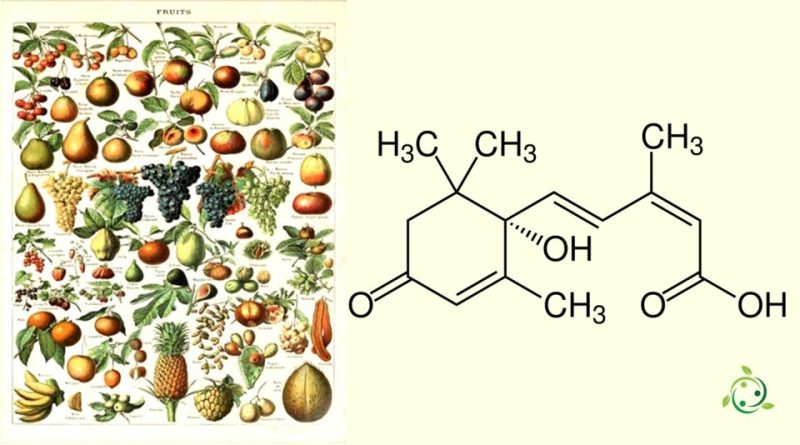Abscisic acid
Abscisic acid
Abscisic acid, whose term in the official IUPAC nomenclature is: acid [S-(Z,E)]-5-(1-hydroxy-2,6,6 -trimethyl-4-oxo-2-cyclohexen- 1- Il)-3-methyl-2,4-pentandienoic acid is a phytohormone or plant hormone involved in the regulation of various growth and development processes in plants.
Abscisic acid (ABA) was first discovered in the 1960s and is extensively studied for its role in the response to environmental stress and in the regulation of dormancy and abscission (drop) of leaves and fruit.
Abscisic acid is a molecule of 15 carbon atoms configured in an aliphatic ring with a double bond, three methyl groups and an unsaturated chain ending in a carboxyl group.
It has the brute or molecular formula: C15H20O4 and is found in nature in the cis form and, by convention, the name refers to this isomer. The structure of ABA resembles the terminal portion of some carotenoids, and in fact the biosynthetic pathway of ABA starts from isopentenyl pyrophosphate (IPP) which leads to the synthesis of violaxanthin, which is then converted into 9′-cis-neoxanthin which is broken down into xanthoxin (a neutral growth inhibitor with ABA-like properties). Xanthoxin is finally converted into ABA-aldehyde which becomes abscisic acid. Finally, ABA is transported by both xylem and phloem where it is most abundant.
ABA is synthesized in various plant tissues, including roots, leaves, seeds and fruits, in response to environmental signals such as drought, cold, excess salts, high concentrations of carbon dioxide and mechanical stress. Once synthesized, it can be translocated within the plant through the vascular system.
Abscisic acid works by binding to specific receptors in plant cells, which in turn activate a cascade of intracellular signals. This receptor activation can lead to various physiological responses, including closure of leaf pores (stomata) to reduce water loss, inhibition of root growth to conserve water in the soil, promotion of sugar accumulation in seeds during maturation and the induction of dormancy in seeds and buds.
The properties of abscisic acid are multiple and comparable to those of cortisol in higher animals: it acts as a negative regulator of growth and stomatal opening under conditions of environmental stress; regulates seed dormancy; acts as an antagonist with auxins, gibberellins and cytokinins; promotes leaf senescence.
It plays an important role in seed dormancy: this function is performed through the synthesis of proteins involved in tolerance to dehydration; accumulation of nutrients in the endosperm during the last stages of embryogenesis; inhibition of α-amylase mRNA synthesis.
It enters leaf senescence by influencing the increase in ethylene formation which stimulates abscission.
Acts on stomatal closure. In the presence of water stress it determines the increase of the pH and of the calcium concentration in the cytosol causing a rapid transient depolarization of the plasmalemma thus causing the release of potassium and anions from the guard cells which loses turgor, deflates and closes the stomatal rim.
It also prevents the stomata from opening in the presence of light: ABA works by inhibiting the incoming potassium channels that are opened when the cell is hyperpolarized by the proton pump. This inhibition appears to be mediated by calcium entry into the cell and cytosol alkalination. Therefore calcium and pH act in two ways: by inhibiting the incoming potassium channels and activating the outgoing anion channels, thus promoting the closure of the stomata.
In summary, abscisic acid is a phytohormone that plays a crucial role in regulating plant growth and development in response to environmental stress signals, contributing to plant survival and adaptation to adverse conditions.
Warning: The information provided is not medical advice and may not be accurate. The contents are for illustrative purposes only and do not replace medical advice.

